|
Special Features





Image Libraries


|
|
Blog
|
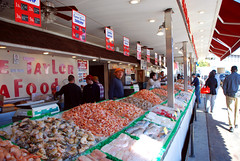
The Maine Avenue market. |
It could be good news that the Maine Avenue fish market will now be allowed to expand its offerings and sell things other than fish. Maybe this will result in a better, more diverse market, akin to the wildly successful Pike Place market in Seattle.
I hope that’s what happens. Because the Maine Avenue market could be better, and Pike Place is awesome.
But I very much hope that fish and shellfish remain the main categories of things sold there. The fish market is one of the most unique and interesting public spaces in DC, and if it’s allowed to become an Eastern Market clone then it will become less unique and interesting. Eastern Market is awesome too, of course, but it’s the fish that make the fish market something to see.
And I don’t even like seafood.
Average Rating: 4.7 out of 5 based on 169 user reviews.
June 29th, 2012 | Permalink
Tags: development, preservation

Most of the posts on BeyondDC are about transportation. Stupidly, these have always been clumped together under a single broad transportation tag.
I’m now going through the 700-some posts tagged with transportation and adding new mode-specific tags, so readers will be able to pull up all posts about streetcars, or bike issues, or whatever.
So far I’ve added mode tags to posts through late 2010. It’ll take a while to finish.
Average Rating: 4.6 out of 5 based on 259 user reviews.
June 28th, 2012 | Permalink
Tags: site

|
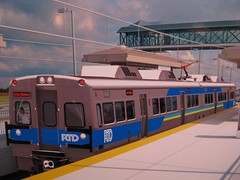
Denver is using a private partnership to build its airport rail line. |
DC is considering turning over construction of 22 miles of proposed streetcar lines to a private company. The idea is that the company would build the lines using its own money, more cheaply and quickly than DC could following the cumbersome government process. Over time the company would make its money back in fares, and DC would more heavily subsidize operations once the streetcars are running.
Nobody has ever done anything quite like this before in the DC region. And so there is a lot of skeptisicm, which is totally healthy and correct. There’s no such thing as free money, so DC should absolutely tread carefully.
But tread carefully doesn’t necessarily mean dismiss the idea outright. Depending on the specifics of how the private sector responds to the city’s inquiry, privatizing streetcars could turn out to be a good deal. It could also turn out to be a loser, of course, but the key will be to consider the responses and not be dogmatic.
The Denver example
Although it’s true that nobody has used a public-private partnership to build a rail transit line in DC, the idea has worked in other cities. The most notable current example is Denver, where they are building a huge 122 mile rail network from scratch, and are using a private partnership to build some of the corridors. The private deal is called the Eagle P3 Project, and it is under construction now, on schedule to open in 2-3 years. In the future, when you take the train from Denver’s airport to its downtown, you’ll be riding on something built and operated much like this streetcar deal proposes for DC.
The Virginia example
Virginia is using the same process to build billions of dollars worth of HOT lanes on I-95 and the Beltway. While it’s true that those projects have been controversial, the private investment has been a key aspect of funding and management.
This is definitely an idea worth exploring. It may or may not be worth doing, but it doesn’t hurt to consider options.
Average Rating: 4.8 out of 5 based on 162 user reviews.
June 27th, 2012 | Permalink
Tags: streetcar, transportation

A Czech company wants to build a flying bicycle. Apparently.
What happens when you get too tired to keep pedaling? And if pedaling isn’t necessary, why make it a bike?
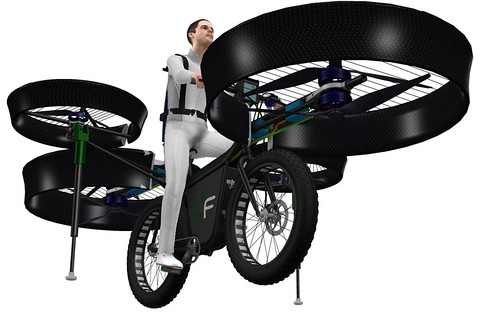
Average Rating: 5 out of 5 based on 170 user reviews.
June 26th, 2012 | Permalink
Tags: bike, fun, transportation

USDOT announced this morning about $500 million in multimodal “TIGER” grants in 47 locations around the US. A combined DC/MD/VA regional application that would have funded $20 million worth of bike/ped projects near Metro stations, as well as bikesharing expansions in Montgomery and Arlington, was not funded. However, DC and MD worked together on one that was.
The winning application received $10 million in federal funds to help pay for a 4-mile extension of the Anacostia Riverwalk Trail. The project will extend the trail along the east shore of the river, from Benning Road NE, through Kenilworth Gardens, to just shy of Bladensburg Road in Prince George’s County. It will include 5 bridge segments, and some raised sections.
This map shows the portion of the riverwalk that is being funded by TIGER. The pink dashed line in upper-right is the project.

TIGER funding is for the pink dashed line section in upper-right.
|

Location of Jefferson Co. West Virginia. |
AnacostiaWaterfront.org has a press release with additional information.
Jefferson County, WV is also a winner
The TIGER grant process stipulated that some percentage of winners had to be in rural areas. One of those rural awards went to Jefferson County, WV, which is the next county west from Loudoun, and is only about 60 miles from DC. They received $5 million in federal funds to help pay for a $24 million project to convert Fairfax Boulevard through the town of Ranson into a complete street, extend Fairfax Boulevard to a retail area on the edge of town, and build a transit center in downtown Charles Town that when complete will be the transfer location for bus service to nearby MARC stations in Harper’s Ferry, WV and Brunswick, MD.
The Town of Ranson’s project fact sheet gives additional details, and I created a map showing the location of the projects.
Average Rating: 4.7 out of 5 based on 215 user reviews.
June 22nd, 2012 | Permalink
Tags: bike, government, transportation

BeyondDC is very slow today. I’m not completely sure why, but one of the reasons appears to be that the comment system isn’t working right. Because of this, comments are temporarily disabled. Sorry for any inconvenience.
Average Rating: 5 out of 5 based on 270 user reviews.
June 22nd, 2012 | Permalink
Tags: site

|
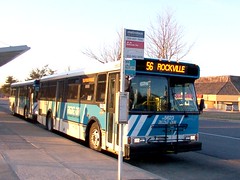
A Ride-On bus in Gaithersburg.
Not BRT. |
A report is making the rounds today that claims the Corridor Cities Transitway BRT line could be built for far less money if buses were routed in mixed traffic rather than on a transitway, if “temporary stops” were built instead of stations, and if park and rides were eliminated from the outer stations.
The report is wrong in one very fundamental way: It is impossible to build a bus rapid transit Corridor Cities Transitway for the amount of money they claim.
What *is* possible is to build something so entirely different from the Corridor Cities Transitway that you couldn’t call it the same thing.
It is totally possible to build a non-rapid, non-transitway bus route for a lot less money. And, in doing so, provide a vastly inferior product that would be vastly less convenient, and which would serve vastly fewer passengers.
The report’s authors claim that their redesign wouldn’t slow buses all that much, but they completely miss the point that ride quality also matters. Eliminating stations in favor of normal bus stops and taking away park and rides might not technically slow buses down, but it would certainly affect ridership.
If highway engineers eliminated the exits from an Interstate highway and replaced them with stop lights, the resulting road wouldn’t be an Interstate highway. That’s essentially what is being proposed here. The changes look small on paper, but they add up to big reductions in quality.
If highway engineers eliminated the exits from an Interstate highway and replaced them with stop lights, the resulting road wouldn’t be an Interstate highway.
|
|
Montgomery County currently operates about 100 Ride-On bus routes. They could easily add a new Route 101, have it run on existing streets along the Corridor Cities Transitway alignment, and call it a day. Doing that would save a lot of money, but it wouldn’t be providing bus rapid transit.
It’s a bit of a straw man to claim the authors of this report want to go that far, but only a bit. Their proposal would strip the CCT of so many of the amenities that separate it from a normal bus route that functionally, it may as well be one. We’d be left with something that looks a lot like MetroExtra; a little better than local buses, but not BRT.
The real kick to the knees here is that anyone who has followed transit development over the last decade could have predicted this. Stripping BRT projects of their amenities is called BRT creep (and here at GGW), and it happens so often that it’s probably inherent to BRT projects.
The good news is that the Montgomery County Council appears to recognize what a terrible idea this is. Councilwoman Nancy Floreen says “I don’t think we want to do the CCT on the cheap … We want to make this as close to a light rail experience as we can.” Councilman Phil Andrews says the proposal “subjects riders to the same traffic that we want to get them out of.”
But sticking to those guns is going to take a lot of political will, over a long and sustained time. It’s going to take years for the CCT to be built, and this is already the second time the news media has picked up on opponents’ proposal to redefine it as a non-BRT line. Presumably they will continue, and the threat of BRT creep will be with the CCT until the day it opens (and maybe after).
Average Rating: 4.5 out of 5 based on 218 user reviews.
June 21st, 2012 | Permalink
Tags: BRT, bus, transportation

Montgomery and Arlington counties have both been very good at turning their Metro stations into TODs. However, the pattern of how they developed in each jurisdiction varies due to the spacing of Metro stations.
In Arlington, stations are clustered close together in two corridors (Rosslyn-Ballston and Pentagon-Crystal City), so that the TOD areas within each corridor function like neighborhoods within the larger “city” of Arlington. In Montgomery, stations are spaced a mile or so apart, resulting in TOD areas that each function as the downtown for otherwise independent cities, each with its own hinterlands.
Because the TODs in Arlington are clustered together, while those in Montgomery are spaced apart, it’s difficult to get a sense of how they compare to each other. Just how big is Silver Spring, compared to Rosslyn or Ballston, for example?
I set out to answer that question with a series of maps. These maps compare the Rosslyn-Ballston corridor’s 5 Metro station TODs to Bethesda, Friendship Heights, and Silver Spring, all at the same scale. I left out Pentagon-Crystal City, Rockville, and Alexandria, although they might make good additions some time in the future.
First, a reference map. Using Google Maps set at the 2, 000 foot view, I colored in the dense portions of each TOD, deleted the surroundings, then put them all on the same page. In this first map, Bethesda and Friendship Heights are shown at the proper distance from each other, in addition to being scaled by area.
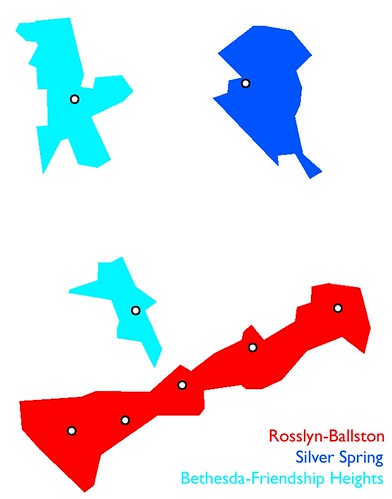
Rotating the Wisconsin Avenue axis of Bethesda-Friendship Heights to match Rosslyn-Ballston, and then placing downtown Silver Spring between them, produces 2 almost identical corridors.
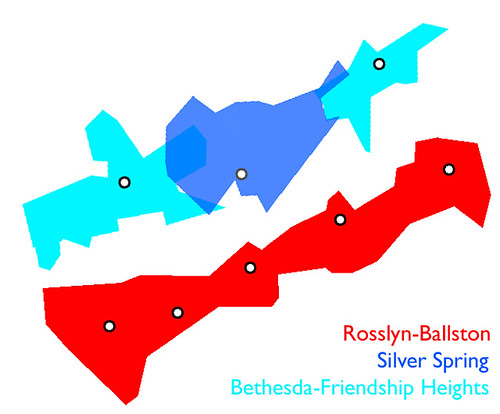
Overlaying Silver Spring and Bethesda atop Clarendon shows that if the Maryland TODs were part of Rosslyn-Ballston, they would each would stretch approximately from Court House to Virginia Square.

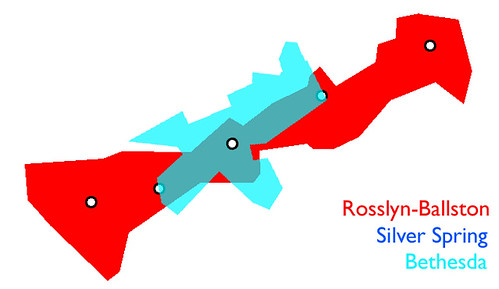
Average Rating: 4.5 out of 5 based on 269 user reviews.
June 19th, 2012 | Permalink
Tags: galleries, urbandesign

Bus bulbs are a simple and effective way to speed up bus service. The basic idea is that rather than forcing buses to pull out of travel lanes for bus stops, and then make them wait for an opening in traffic before pulling back in when they’re ready to leave, you simply have buses stop in the travel lane, and extend the sidewalk out to the street.
Here is a simple diagram illustrating the concept, and here is a real world example from Russia.
Sidewalks extensions are relatively cheap and easy to build compared to many other things. Nonetheless, it takes months of planning and a fair amount of funding for public agencies to do them. Plus, of course, there’s the accompanying disruption that comes with construction.
The attached image shows an easier, cheaper, and faster alternative. It’s a pre-fab unit installed in Barcelona, Spain. It accomplishes all the same goals as a regular sidewalk extension would, but is easier in just about every way.
Without having actually used one of these or seen one up close, the major downside appears to be that the pre-fab unit isn’t as pretty as a real sidewalk. It looks a little bit cheap and tacked on. Which of course it is; that’s the idea.
Would we want these on Pennsylvania Avenue or in front of the White House? Probably not. But they might very well be a reasonable way to make transit improvements on less monumental streets.
Average Rating: 4.7 out of 5 based on 188 user reviews.
June 14th, 2012 | Permalink
Tags: bus, transportation, urbandesign

In case you missed it, in April the WMATA Board officially finalized and adopted the names for Silver Line stations that will be in Fairfax County. From east to west, the station names will be: McLean, Tysons Corner, Greensboro, Spring Hill, Wiehle-Reston East, Reston Town Center, Herndon, Innovation Center.
If Loudoun County elects to remain a part of the Silver Line project, its stations will be officially named later. For now they remain unofficially Dulles Airport, Route 606, and Route 772.
Here’s a mock-up of what the Metro map will look like with the new names (showing Phase 1 only):

Average Rating: 4.5 out of 5 based on 254 user reviews.
June 12th, 2012 | Permalink
Tags: metrorail, transportation

|
Media





Site
About BeyondDC
Archive 2003-06
Contact
Category Tags:
Partners
|

























